전시
-
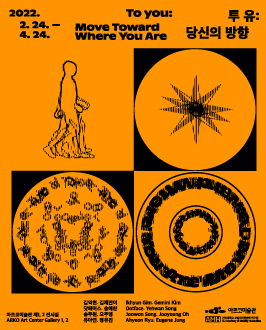 2022 아르코미술관 주제기획전 《투 유: 당신의 방향》
2022 아르코미술관 주제기획전 《투 유: 당신의 방향》- 전시기간
- 2022.02.24~2022.04.24
- 관람료
- 무료
- 오프닝
- 별도 오프닝 행사 없음
- 장소
- 아르코미술관 1,2 전시실
- 작가
- 김익현, 김재민이, 닷페이스, 송예환, 송주원, 오주영, 유아연, 정유진
- 부대행사
- 학술행사 외(관련 일정 추후 공지 예정)
- 주관
- 아르코미술관
- 주최
- 한국문화예술위원회
- 문의
- 02-760-4850/arkoevent@arko.or.kr
2022 아르코미술관 주제기획전 《투 유: 당신의 방향》
▣ 전시개요
- 제목 : 2022 아르코미술관 주제기획전 《투 유: 당신의 방향》
- 작가 : 김익현, 김재민이, 닷페이스, 송예환, 송주원, 오주영, 유아연, 정유진
- 기간 : 2022년 2월 24일(목) - 4월24일(일)
- 운영시간 : 화-토요일, 오전 11시 – 오후 7시/월요일 휴관
- 장소 : 아르코미술관 1,2전시실
- 관람료 : 무료
- 주최 : 한국문화예술위원회
- 관람예약 바로 가기 : https://c11.kr/wvht
- 전시 리플렛 다운로드
- 이동약자를 위한 아르코미술관 이용 매뉴얼
최근 친환경 모빌리티, 공유 모빌리티, 스마트 모빌리티 등 ‘모빌리티’와 연결된 단어들을 심심찮게 들을 수 있습니다. 팬데믹으로 이동이 제한되어 안전하고 효율적인 이동에 대한 관심이 급증하면서 모빌리티는 여러 단어들과 결합해 우리가 상상하던 기술의 현전을 기대하게 만듭니다. 그래서 모빌리티는 2022년의 키워드로 자리매김했다고 봐도 과언이 아닙니다.
그런데 이렇게 여러 단어와 결합하는 모빌리티의 의미는 무엇일까요. 사전 상 모빌리티는 ‘이동성’, ‘유동성’으로 꽤 큰 범위의 의미를 보유하고 있습니다. 결국 모빌리티가 주요한 키워드가 된 것은 그만큼 이동에 대한 관심이 높아졌기 때문일 것입니다.
돌이켜보면 팬데믹 이전 우리의 삶에서 이동하는 일은 의식할 필요가 없던 그저 당연한 것이었습니다. 세계인권선언 13조 1항에 “모든 인간은 자국 내에서 이동의 자유가 있다”고 명시되어 있듯 이동은 모든 생물의 삶을 영위하기 위한 기본적인 행위이자 권리입니다. 소와 말 등 비인간 동물을 통한 이동에서부터 마차와 자전거, 자동차, 기차, 비행기까지 인간은 움직임과 이동의 범위를 확장하여 역사를 형성해 왔습니다.
하지만 《투 유: 당신의 방향》이 이동수단으로서의 모빌리티의 미래와 그 기술의 가능성을 논하려는 전시는 아닙니다. 다만 주체적인 행위라고 믿었던 나의 이동이 통제될 수 있음을 확인하며 이에 따라 변화한 사회와 그 경험의 단면을 들여다보고 이동의 구조가 과연 모두에게 평등한가를 질문하고자 합니다.
국내외는 물론 근교를 이동할 수 있는 기회들이 줄어들거나 억제되며 각종 경제활동이 위축되는 한편 면세품을 소비할 수 있는 무착륙 관광 비행은 인기를 끌고 있습니다. 내비게이션이 없으면 길을 잃고, 인공지능을 기반으로 한 배달 시스템은 신선식품의 새벽 배송을 가능케 하며 식당에서는 사람이 아닌 로봇이 서빙 하는 음식을 받을 수 있습니다. 농장, 공장 등 생산의 주체들이 혐오 시설이 되어 개발의 논리를 통해 외곽으로 밀려나는 한편 신기술을 도입한 모빌리티 도시를 만들겠다는 정책들이 쏟아지고, 지하철에서는 장애인들의 이동권 투쟁이 계속됩니다.
이러한 풍경의 이상을 감지한 ‘당신의 방향’은 인간을 포함한 모든 것들의 이동 방향이 어떻게 사회 구조의 형식과 결속의 방식을 변화시키는지를 질문하는 제목입니다. 그래서 《투 유: 당신의 방향》 은 무한하고 동등하게 주어진 자유인 줄 알았던 이동이 권력과 배제의 수단이자 네트워크 자본(network capital)으로 기능하는 시대임을 감지하고 이동이 가진 오늘날의 다각적 의미와 작동의 형태를 들여다봅니다. 완벽한 일상으로의 복귀가 쉬이 도래하지 않을 시대를 통과하면서, 우리에게 이동의 방식과 형태의 문제는 지속적으로 감지될 것이기 때문입니다.
8명(팀)의 참여 작가들은 각자가 경험한 이동과 관련된 문제들을 펼칩니다. 중심(수도권)으로 이동, 떠나야하거나 혹은 남겨져야하는 존재들, 팬데믹 이후 더욱 각광받는 플랫폼 노동이 타인의 신체를 대여하고 서비스를 이용하는 방식, 오프라인의 대안처럼 부상했지만 실상 제한적인 웹(web)의 구조를 전복하고 감각 체계의 충돌을 재고하는 이미지, 사회적 소수자들의 신체와 상황이 고려되지 않은 모빌리티 상황을 전복하는 방식을 살핍니다.
《투 유: 당신의 방향》이 미처 닿지 못한 수많은 이동의 지점과 문제들을 함께 나누며, 전시장에서의 ‘당신’의 이동과 그 방향이 어떤 의미를 가질 수 있을지를 질문하고 상상하기를 기대해 봅니다.
▣ 작품 소개
김익현, 〈그늘과 그림자〉, 2022, 단채널 비디오, P3 LED 매트릭스, 컬러, 사운드, 25분 30초
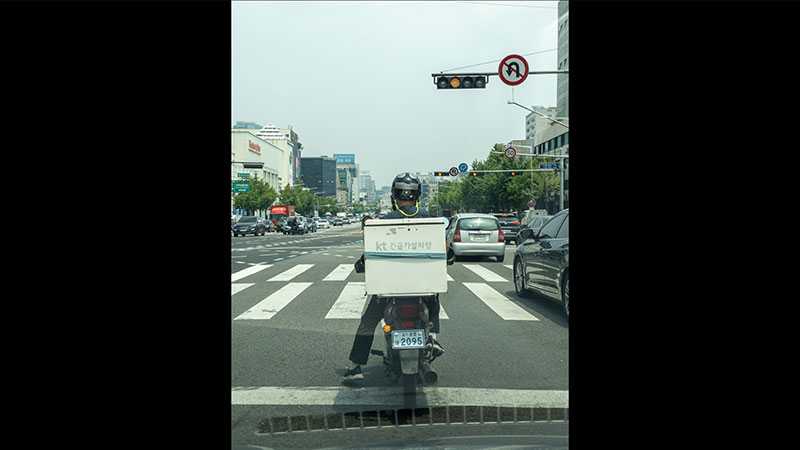
두 작품은 2018년 11월 24일부터 2021년 10월 25일의 시간 동안 촬영한 사진들로 구성된다. 양일은 모두 KT 통신망 마비로 인해 일상 및 경제활동이 일시적으로 멈춘 날이다. 작가는 그 시간 사이를 걸으며 망이 손상되면 사라져버릴 사진들을 기록한다. 매일매일 수많은 사진들이 광케이블을 타고 반짝이는 빛으로 변환되어 눈앞에 나타난다. 이들은 택배로 주문한 물건을 직접 확인하기도 전에 도착을 공지하거나, 클라우드에 남아 몇 년 전의 추억을 알리고, 알고리즘과 타임라인을 통해 당신의 눈을 실어 나른다. 혹은 과거나 미래의 이동을 어느 시점으로 옮기거나 판단을 유도한다. 인간의 눈과 기계의 눈이 공존하는 디지털 네트워크의 세계에서 사진 데이터는 정확한 기록도 현실도 아닌 채 감각과 인식을 혼동시키며 망과 망 사이를 유영한다. 작가는 우리의 눈앞에서 밝게 빛나는 사진 대신, 그 뒤에 존재하는 그림자를 살핀다.
김재민이, 〈돼지똥과 아파트〉, 2022, 단채널 비디오, 15분
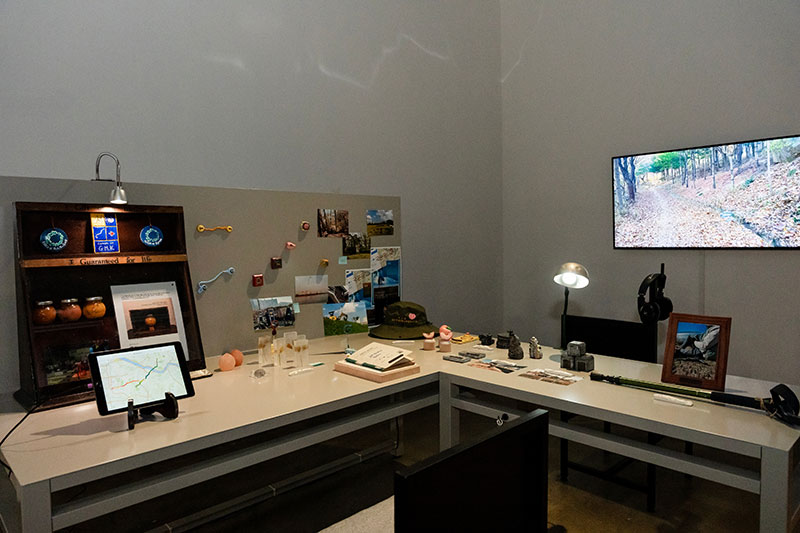
작가는 과거 용산과 나주에 있던 공장 및 농장의 이동 과정을 좇는다. 이들이 계속해서 자리를 옮겨야 하는 이유는 바로 ‘냄새’ 이다. 이러한 현실은 영화 「기생충」(2019)의 주요 인물인 오근세와 국문광을 주인공으로 한 〈냄새의 경계선3-기생충 순례길〉(2022)에서도 드러난다. 작가는 극 중 부천과 광명 출신인 이들이 어떻게 서울의 상류층에 입성하고 한편으로 실패했는지를 순례길로 상정해 상상의 기념품들과 아카이브를 비치한다.
정유진, 〈돌고 돌고 돌아〉, 2022, 혼합매체, 가변크기
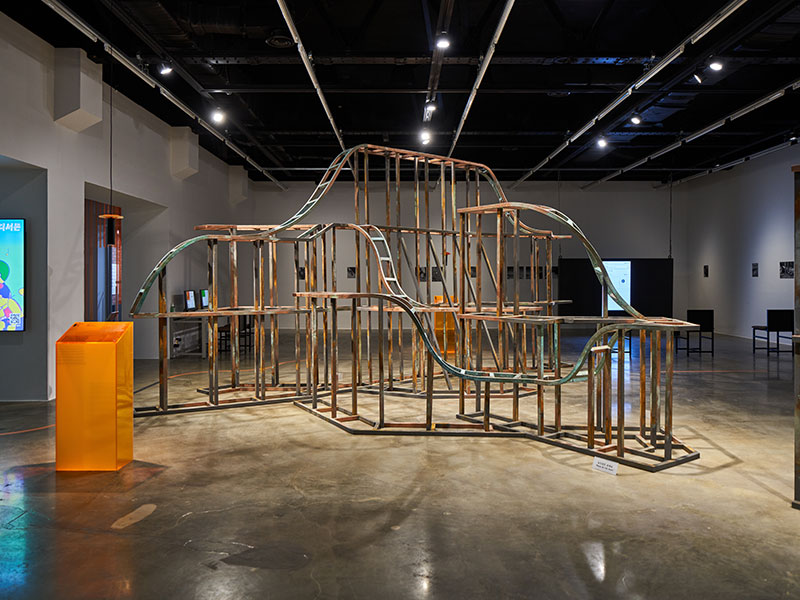
팬데믹으로 인해 쉬이 해외로 이동할 수 없는 상황에서 항공사들과 면세업계는 땅에 멈춘 비행기의 연료와 주차비를 절약하기 위해 ‘무착륙비행’을 개발했다. 면세품 구매를 촉진하고 이벤트로서의 비행을 자처하는 무착륙 비행의 움직임은 정착 없이 돌아오는 롤러코스터를 닮아 있다. 찰나의 즐거움을 위해 고점과 저점을 반복하는 둘의 모습은 이동을 위한 이동으로, 소비의 흐름을 끊지 않으려는 시스템과 맞닿는다.
송예환, 〈월드 와이드〉, 2022, 폼보드 위에 프로젝션 매핑, 폼보드, 빔프로젝터, 혼합매체, 가변크기
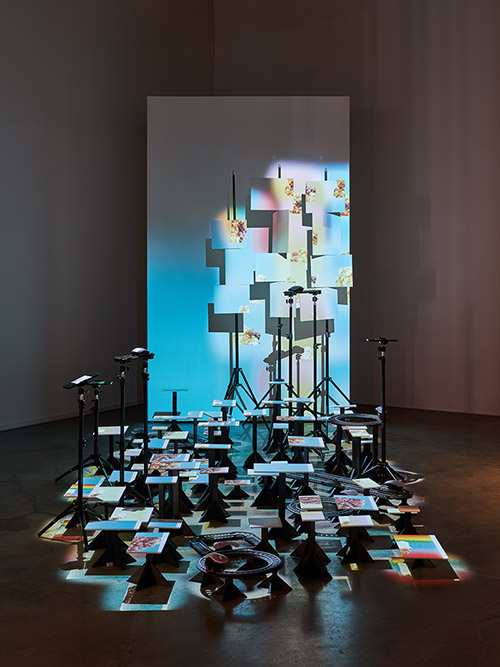
팬데믹 이후 가상세계에서의 정보 공유는 더욱 각광받으며 새로운 세계를 여는 포털처럼 보인다. 그러나 그래픽 디자이너인 송예환은 이러한 환상에 제동을 걸고 제한된 웹 환경이 개인의 환경이나 문화적 차이를 경시한 채 일반화된 상호작용과 시각을 강요하는 현실을 드러낸다. 또한 우리가 사용하는 웹 플랫폼들이 과연 ‘모두’에게 공평하게 혹은 충분히 접근 가능한 공간인지를 질문한다.
닷페이스, 〈우리는 어디서든 길을 열지〉, 2021, 10초 반복재생
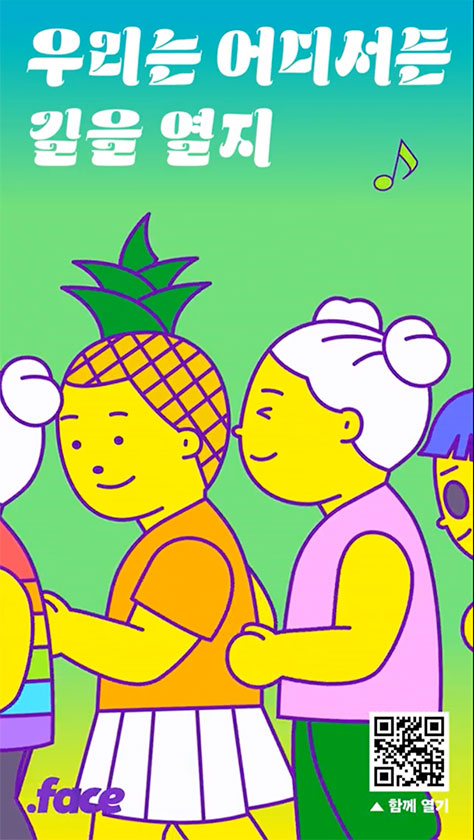
미디어 스타트업 닷페이스는 2020년 팬데믹으로 인해 퀴어 퍼레이드를 개최할 수 없는 상황에 대응하여 온라인 퀴어 퍼레이드를 기획했다. 자신만의 캐릭터와 메시지를 만들어 SNS 등에 공유, 확산되었던 이 행사는 “우리는 어디서든 길을 열지”, “우리는 없던 길도 만들지”라는 문구를 통해 이동이 어려운 혹은 불가능한 시대를 사는 이들이 편견 없이 자신의 생각을 적극적으로 발화, 협력할 수 있는 장소에 대한 기대이자 가능성을 상징한다.
유아연, 〈벌레스크〉, 2021, 단채널 비디오, 29분 9초
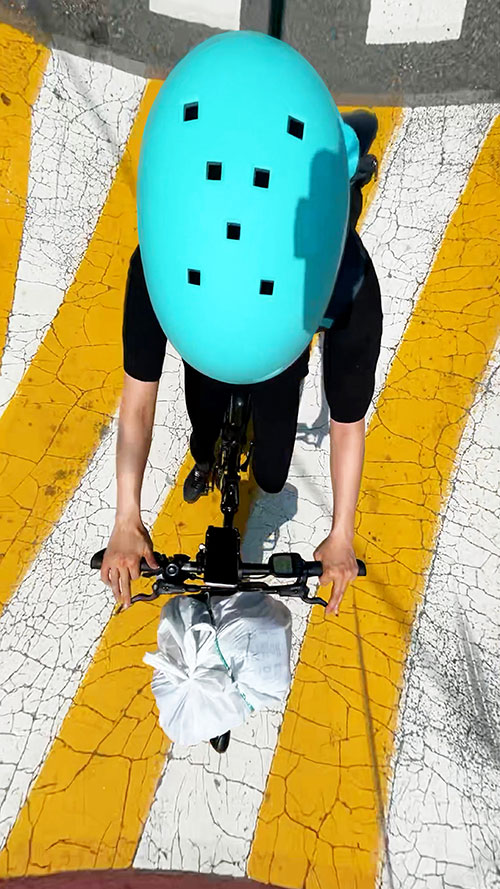
시대에 따라 변하는 노동의 양상에 주목하는 작가는 노동을 수행하고 서비스를 제공받는 관계를 전시장에 구현한다. 입구에서 받은 진동벨이 울리면 관객은 전시장을 돌아다니는 서빙 로봇에게 이를 반납할 수 있다. 작가는 반납이라는 이동 행위를 전제로 제공되는 서비스에 불필요한 접촉 및 정보를 끼워 넣음으로써 서비스 노동, 플랫폼 노동 등 노동의 주체는 삭제되고 용이하게 결과만을 소비하는 작금의 구조를 가시화한다.
오주영, 〈구름의 영역〉, 2021, 아케이드 PC게임, 컨트롤러, 네온사인, 가변크기
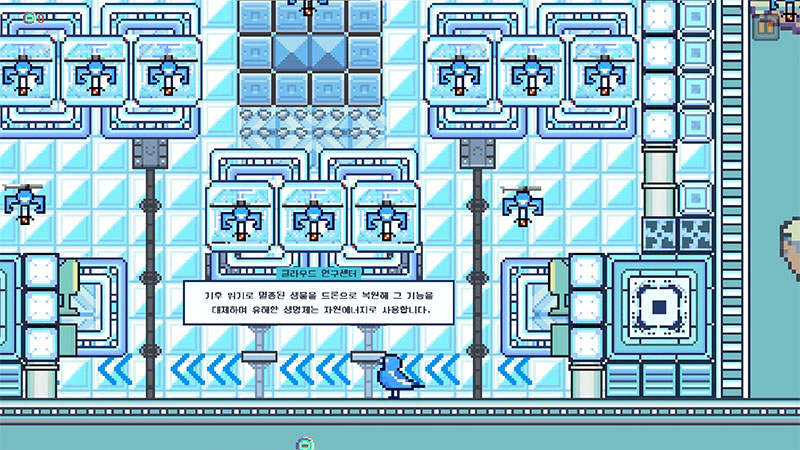
〈구름의 영역〉은 최근 각광받는 항공 모빌리티(UAM, Urban Air Mobility) 등 새로운 이동 기술이 초래할 딜레마를 고찰하고 상상한다. 세 개의 아케이드 게임으로 구성된 이 작품은 미래의 어느 시대, 뜨거워진 대기로 인해 상공 도시에 살아야 하는 기후 위기 난민과 인간에게 하늘을 빼앗겨 날지 못하는 새의 생존 관계를 다룬다. 플레이어의 선택으로 달라지는 엔딩에는 미래 이동 기술이 내재한 생명윤리 및 환경문제를 반영한다.
송주원, 〈마후라〉, 2021, 3채널 비디오, 10분 22초
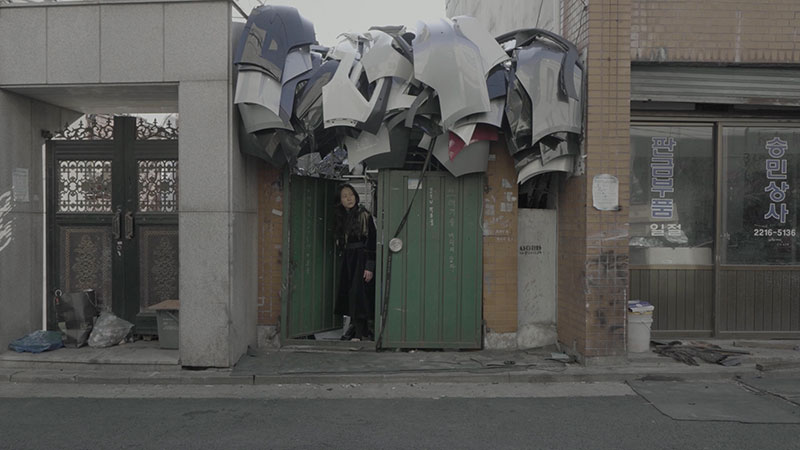
〈마후라〉는 아시아 최대 중고차 시장이었지만 재개발을 앞둔 장안평 일부와 자동차의 풍경을 담는다. 걷잡을 수 없이 빨라지는 기술의 변화 속도와 코로나19로 인해 사장된 시장 상황 등으로 금세 구형이 된 자동차 기체들은 중고차 시장에서 해체를 기다린다. 작가는 이들을 퍼포머의 신체와 결합해 생명력을 부여하여 유령처럼 지역을 맴돌게 만든다. 전시의 인트로인 이 작품은 이동, 기계 모빌리티, 그리고 도시를 구성하는 존재들이 밀려나고 밀려드는 관계를 고찰한다.
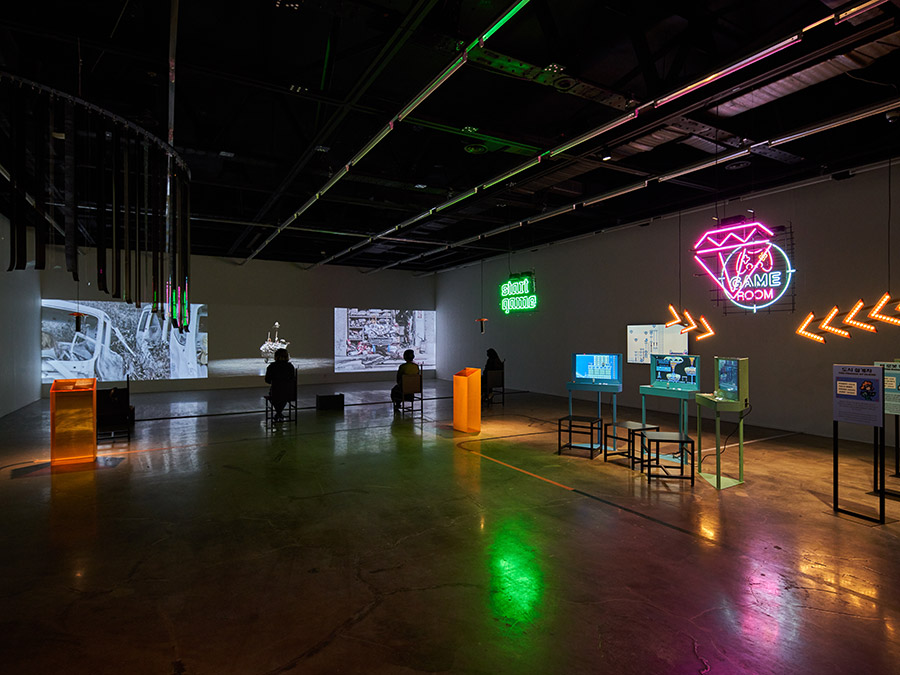
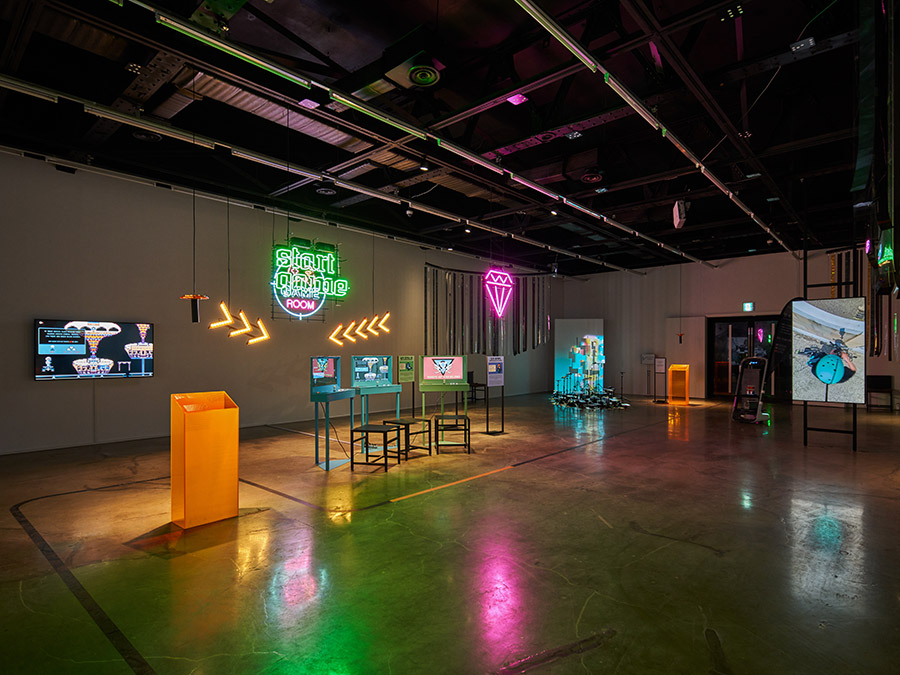
1층 전시 전경
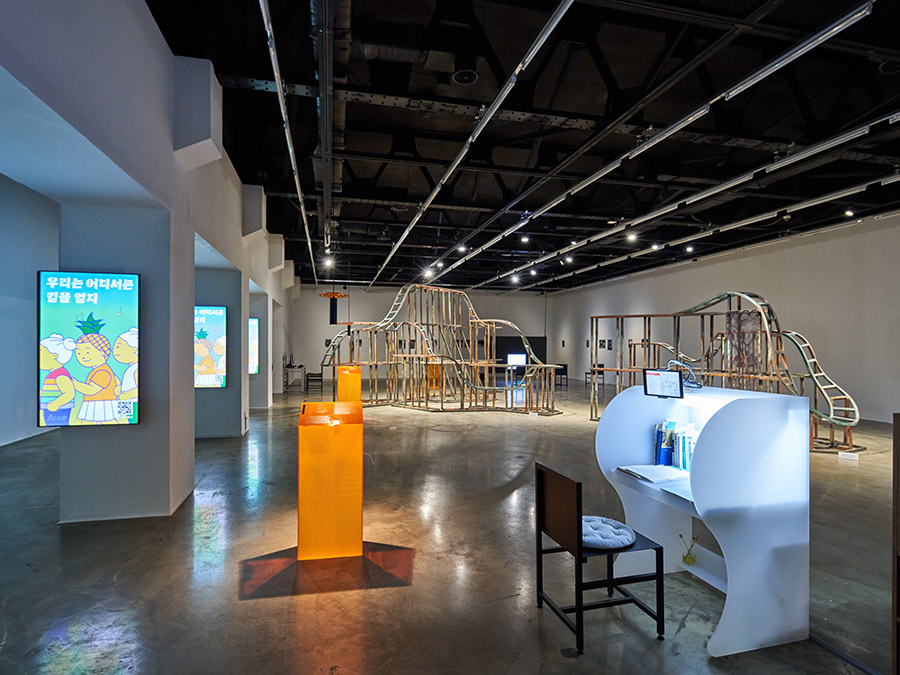
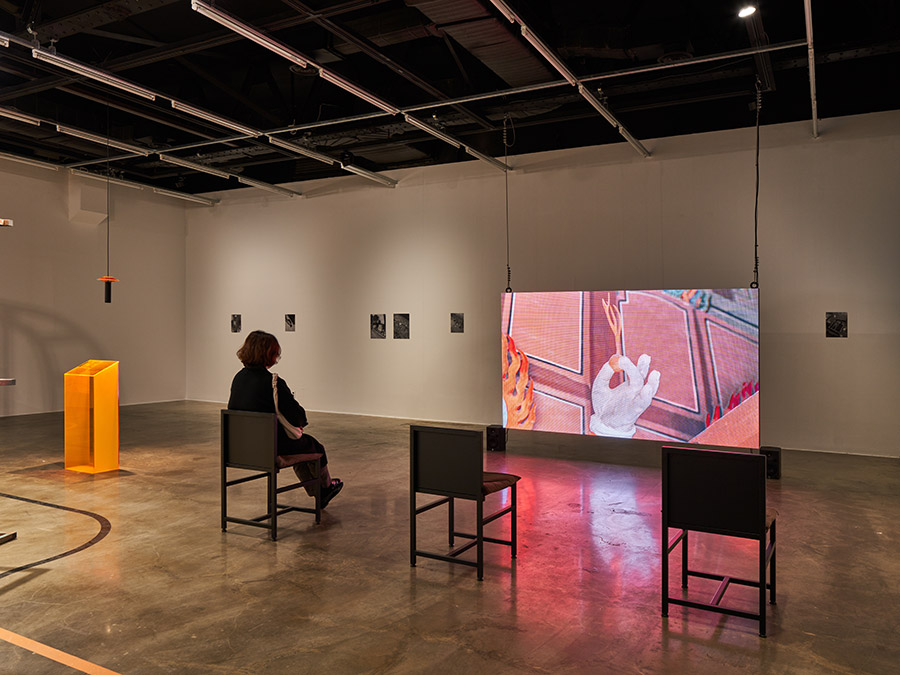
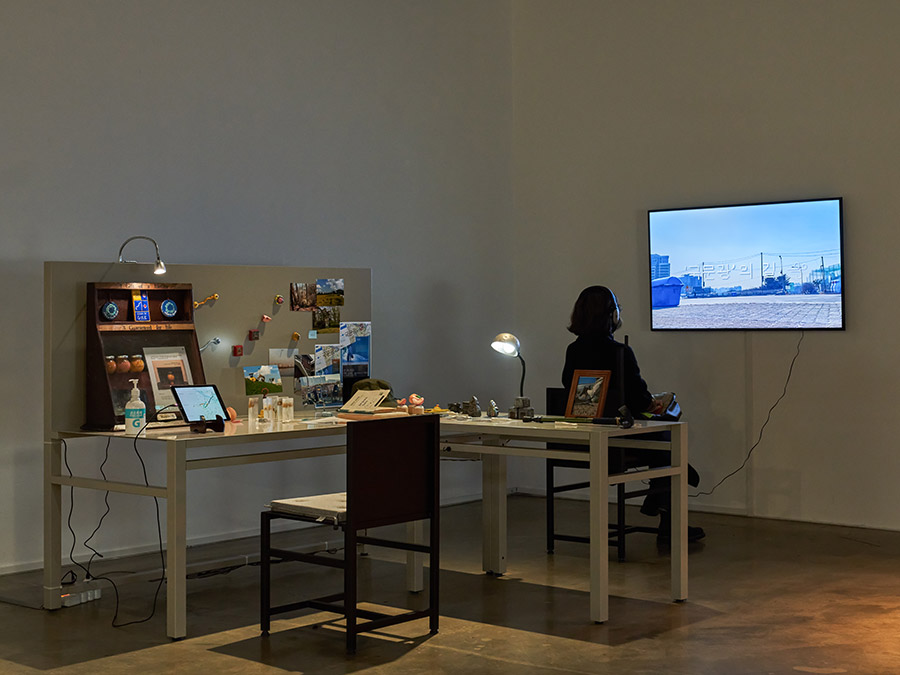
2층 전시 전경
자료담당자[기준일(2022.2.25.)] : 아르코미술관 김미정 02-760-4617
게시기간 : 22.2.25. ~
2022 ARKO Art Center Thematic Exhibition To you: Move Toward Where You Are
- Artists : Ikhyun Gim, Gemini Kim, Dotface, Yehwan Song, Joowon Song, Jooyoung Oh, Ahyeon Ryu, Eugene Jung
- Period : 2022. 2. 24. - 2022. 4. 24.
- Venue : ARKO Art Center, Gallery 1, 2
- Opening Hours : 11am-7pm (Closed on Mondays)
- Admission : Free
“Mobility”
Recently, one frequently encounters compound words containing “mobility,” such as “eco-friendly mobility,” “shared mobility,” “smart mobility,” and others. Moreover, as the pandemic has hindered travel and there is a fast-growing interest in safe and efficient movability, the word mobility, joined by different terms, allows one to anticipate an emergence of the technology that has been dreamt of. Therefore, it is no overstatement that mobility has established itself as a keyword of the year 2022.
Then, what is the meaning of “mobility,” which can be versatilely combined with other terms? Dictionaries show a wide range of definitions of the word, such as “movability” and “fluidity.” Mobility has become significant because people are paying more attention to moving from one place to another.
Upon reflection, moving in pre-pandemic life did not require conscious awareness and was therefore taken for granted. However, as the Universal Declaration of Human Rights Article 13.1 states, “Everyone has the right to freedom of movement and residence within the borders of each state,” movability is all life forms’ fundamental gesture and right to carry on with their life. As a result, humans have enlarged the scope of their movement from traveling using non-human animals like cows and horses to wagons, bikes, cars, trains, and airplanes and developed their history.
However, the exhibition To you: Move Toward Where You Are does not intend to discuss the future of mobility as means of transportation and its technological possibilities. Simply, it acknowledges that moving, considered an independent act, can be, in fact, very much regulated. While looking into the society and aspects of the experience altered by restrictions, the exhibit hopes to question whether everyone is treated equally in the structure of mobility.
As national and international travel opportunities, as well as trips to suburbs, are reduced and discouraged and various economic activities are declining, no-landing flights that include duty-free shopping are gaining popularity. Nowadays, it is easy to get lost without navigation, and AI-based delivery services allow one to receive fresh food early in the morning. And robots wait tables instead of humans at restaurants. The subjects of production, such as farms and factories, are now considered “hateful facilities” and pushed out to the outskirts of the cities, surrendering to the developmental logic. Politicians are pouring out policies for creating cities with mobility featuring cutting-edge technology. On the other hand, the disabled are fighting continuously for their mobility rights on the subways.
With a suggestion of the peculiarity of the circumstances mentioned above, the exhibition title Move Toward Where You Are asks how the moving directions of all things, including human beings, alter the structure of society and solidarity. Thus, To you: Move Toward Where You Are notes the current time when mobility, which used to be considered infinitely and equally available, functions as a means of power, exclusion, and network capital. At the same time, it investigates the multilateral aspects of today’s mobility and its operation. As one goes through an era when returning to everyday life seems almost unrealistic, the issues raised in how one moves around will keep being reminded.
The eight artists (teams) in the exhibition present mobility-related concerns discovered from their own experiences. They are about those who have to move to the center (metropolitan areas) or be left behind; how platform labor, which has received more attention since the pandemic, borrows the bodies of others and utilizes services; images that overturn the web system, which has emerged as an alternative to offline activities but are rather inadequate in reality, and that reconsider the collision between sensory systems; and the ways of turning over the state of mobility in which social minorities’ bodies and circumstances are overlooked.
To you: Move toward Where You Are hopes to inspire sharing of the numerous points and problems of movement that have not yet been reached. The exhibition will also help ask and envision what your movement and direction in the gallery can signify.
Ikhyun Gim, Shade and Shadow, 2022, single-channel video on P3 LED matrix, color, sound, 25min 30sec

The artist's new works consist of photographs taken from November 24, 2018 to October 25, 2021. The KT network was paralyzed on both dates, which paused daily and economic activities. The artist walks between the two times, recording photographs that will be gone when the network is damaged.
Numerous pictures travel via fiber optic cables every day to be converted into shiny light and appear before the eyes. These pictures announce a package’s delivery even before the recipient confirms its contents, and they remain in cloud storage, bringing out memories from several years ago. They carry one’s eyes via algorithms and timelines. They also reposition the movement in the past or the future to a certain point or induce one’s evaluation of them. In the world of digital networks where human and machine eyes coexist, being neither accurate documentation nor reality, photographic data drifts around between networks, confusing one’s senses and perceptions. Instead of the illuminating photographs the eyes see, the artist looks into the shadows behind them.
Gemini Kim, Pip poop & Apartment, 2022, single-channel video, 15min

The artist follows the relocation of the factories and farms that used to be in Yongsan and Naju. Their odors keep pushing them out to regions. For a clean and exhilarating new city, anything that invokes disgust must go somewhere invisible. Therefore, factory workers and livestock must hide in the shade. Such reality is presented in Borderline/Ordorline3-Parasite Pilgrimage (2022), which features Geun-sae Oh and Moon-kwang Guk, main characters of the film Parasite (2019). Following how the two (one from Bucheon and the other from Gwangmyeong) enter a high-class society in Seoul and how their efforts fail, the artist recreates their paths into a pilgrimage with imaginary souvenirs and archives arranged. Through this project, Kim reflects on the multilateral circumstances of life, including one’s overflowing desire to move to a central area, local crisis and development, and others.
Eugene Jung, Round and round, 2022, mixed media, dimensions variable

As international travel has been restricted, airline companies and duty-free shops came up with “no-landing flight” services to save fuel and parking costs. The route of a no-landing flight, which stimulates duty-free shopping and presents itself as an event, resembles a rollercoaster that leaves and comes back without stopping. Using the Flightradar24 app, the artist compares the recorded passage of no-landing flights, which depart only to return to their starting points, to a rollercoaster’s path and creates a sculpture. Their motions, which repeatedly go up and down for a short-lived joy, are moving for the sake of moving. They are also closely connected to the system that maintains the flow of consumption.
Yehwan Song, woldeu waideu, 2022, mixed media, dimensions variable

Since the pandemic, information sharing in the virtual world has been more enthusiastically received and treated like a portal to a new world. However, graphic designer Song puts the brakes on such an illusion by revealing that the limited web environment disregards cultural differences between individuals and enforces generalized interaction and perspective. The artist also questions whether the web platforms are equally and fully accessible to everyone.
Dotface, Pride Open Road Everywhere, 2021, 10sec loop

Media start-up Dotface organized an online queer parade to respond to the 2020 pandemic that prohibited an outdoor queer parade. Participants were able to design their own characters, write slogans, and spread them over social media. The event allowed people to voice their opinions and solidarity with one another when social minorities were physically and psychologically discriminated against. This online parade ultimately created a picture where both their supporters and opponents walked together as participants. Phrases such as “Pride Open Road Everywhere” and “We will make a road that never existed” represent the eagerness and prospects for a place where those living with their mobility impeded and disabled can speak their minds and cooperate without prejudice.
Ahyeon Ryu, Burlesque - Delivery, single-channel video, 29min 9sec

Burlesque-Delivery features the artist, a platform worker, in motion for a delivery. A pilates instructor’s voice asking to control the body plays over the image. Today, one’s body continuously regulates and restricts itself to perform various labors. Ryu recognizes aspects of labor, which differ in each era. The artist’s new work Polite Guys realizes a relationship between employees and customers. The audience picks up a buzzer at the entrance, and when it goes off, they return it to a serving robot in the gallery. While functioning as a dropꠓoff place and mediating the audience’s task performance, the robots display the ads that encourages the audience to join the system of consumption and distribution. The experience—in which information can only be confirmed after a robot’s and the audience’s physical movements are crossed—differs from typical services requiring just a few touches. By introducing unnecessary contacts and information to the service based on the movement, which is an action of returning, the work visualizes current systems where the subjects of labor—such as service labor and platform labor—are erased, and only the end products are easily consumed.
Jooyoung Oh, Scope of the Cloud, 2021, PC arcade game, game controller, neon signs, dimensions variable

If a bird flies to the front of the airplane you are on board, would you shoot it down or keep moving forward despite collision-induced risks? Scope of the Cloud looks into the dilemma introduced by the new, popular technologies such as UAM (Urban Air Mobility), which have recently been in the spotlight. The work consists of three arcade games that deal with the survival of birds, which can no longer fly in the sky taken over by climate crisis refugees. The refugees must dwell in the raised up buildings above the atmosphere that has become too warmed up. One can play each game as a bird, designer, or researcher, and they are faced with how to cope with each character’s situation. The ending, dictated by the player’s decisions, reflects the bioethics and environmental issues inherent in future mobility technology
Joowon Song, Muffler, 2021, three-channel video, 10min 22sec

Muffler shows areas of Janganpyeong with “carscapes.” Once Asia’s largest used car market, the site is now about to undergo redevelopment. Automobiles represent mobility, substituting for being on foot by saving time and effort. Janganpyeong tries to make its regional characteristics visible with the phrase “Mobility Jangan.” However, the cars, already outdated models due to the swift technology development and the market situation shaped by the Covid-19 outbreak, are now waiting for disassembly at used car stores. The artist enlivens them by adding performers’ bodies, leaving them to roam around the region like ghosts. Serving as an introductory piece to the exhibition, Muffler delves into the relationship between movement, machine mobility, and the city-dwellers driving out each other and being pushed out.
▣ Exhibition view


1st floor



2st floor
자료담당자[기준일(2022.7.29.)] : 아르코미술관 김미정 02-760-4617
게시기간 : 22.7.29. ~